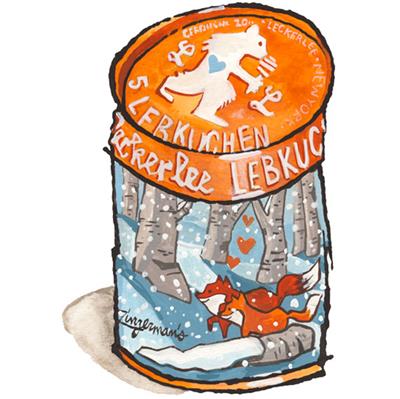The Germans know their Christmas cookies. Depending on where you hail from, you might celebrate with spicy little pfeffernüsse or anise-scented springerles. But the real showstoppers are thick and chewy lebkuchen.
Lebkuchen are the Christmas cookie of Nuremberg, Germany.
They date back to at least the 1300s, when the monks in Nuremberg first started baking them. They’re huge—about four inches in diameter and nearly an inch tall. The best ones are made with honey, spices like cinnamon and nutmeg, a bit of candied citrus, plenty of ground almonds and hazelnuts, and just a smidge of flour.
It’s not an accident that Nuremberg is the home of lebkuchen. In the middle ages, as merchants traveled inland from Venice and Genoa, Nuremberg was one of the central hubs of the continental spice trade. That gave the bakers of Nuremberg better access to exotic flavors cinnamon, nutmeg, cardamom, ginger, anise, coriander, clove, and black pepper—all of which show up in lebkuchen. Nuremberg was also surrounded by a dense forest that was so famous for its honey bees that it was known as “The German Empire’s bee garden.” At the time cane sugar had to be imported from India, making it incredibly expensive and making the local honey the preferred sweetener of the day.
Even with access to the ingredients, lebkuchen were a luxury. Spices and citrus were rarities, making them incredibly expensive. They would have been saved for special occasions, like Christmas… or like when an emperor wanted to show off. Story has it that in 1487 Emperor Friedrich III visited Nuremberg and marked the occasion by giving out lebkuchen bearing his portrait to nearly 4,000 children.
Sandy Lee bakes traditional lebkuchen in New York City.
She first tasted lebkuchen at a Christmas market while she was living in Berlin. In her own words, she “became obsessed” with them, and started baking up a storm to recreate them in her own kitchen. After more than a year of testing and tweaking, she finally settled on a recipe. In 2011, after moving to New York, she launched her lebkuchen business baking thousands of cookies each year around Christmas only.
Sandy uses all of the traditional ingredients to make her lebkuchen: plenty of nuts, honey, candied citron and orange peel, warm spices. Each cookie has an edible oblaten wafer (essentially an oversized communion wafer) on the bottom—a medieval monk innovation to keep the sticky dough from adhering to the cookie sheets. But Sandy also takes her recipe a step further: she follows the traditions laid out in 1808 by the Nuremberg lebkuchen bakers’ guild for “Elisen Lebkuchen,” the highest quality lebkuchen. The rules stipulate that the best lebkuchen must be made with at least 25% almonds and/or hazelnuts and/or walnuts. Sandy’s lebkuchen are made with around 40% almonds and hazelnuts, all ground into a fine powder to give the cookies a smooth but crumbly texture. The rules also say that the best lebkuchen can contain no more than 10% wheat flour. Sandy’s cookies fit the bill.
Lebkuchen make a great gift for anyone who loves cookies as much as Santa does.
In Nuremberg it’s traditional for lebkuchen to be packaged in decorative tins. New this year, our lebkuchen come in tins designed by Zingerman’s in-house artist extraordinaire, Ryan Stiner. They show a whimsical, woodsy, wintry scene laid out in front of Zingerman’s Delicatessen. They’re a gorgeous present—no extra gift wrapping required. Each tin contains five enormous cookies: three coated with a powdered sugar glaze, and two covered in a shell of rich dark chocolate.
When you take a bite, first you taste the warm spices: the cinnamon and clove and nutmeg. Then there’s a bright note from the candied citrus, and a toasty, rich nuttiness. They’re dense and chewy, so it’s great to have something to sip with them: a cool glass of milk, a hot mug of tea, or a snifter of brandy. Or you could eat them the way the medieval monks did: with beer.

